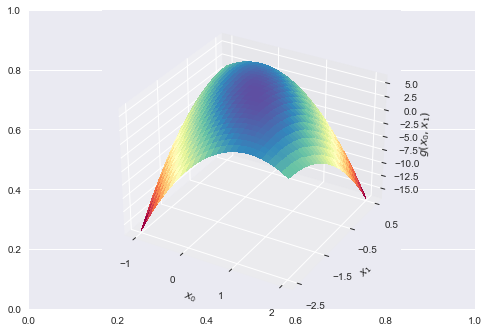Optimization with qnewton
Contents
Optimization with qnewton¶
Randall Romero Aguilar, PhD
This demo is based on the original Matlab demo accompanying the Computational Economics and Finance 2001 textbook by Mario Miranda and Paul Fackler.
Original (Matlab) CompEcon file: demopt05.m
Running this file requires the Python version of CompEcon. This can be installed with pip by running
!pip install compecon --upgrade
Last updated: 2021-Oct-01
from compecon import OP
import numpy as np
import matplotlib.pyplot as plt
from matplotlib import cm
np.set_printoptions(precision=4,suppress=True)
plt.style.use('seaborn')
Example 1¶
Find the optimal value of $\(f(x) = x^3 - 12x^2 + 36x + 8\)$
def f(x):
return x ** 3 - 12 * x ** 2 + 36 * x + 8
F = OP(f)
x = F.qnewton(x0=4.0)
J = F.jacobian(x)
E = np.linalg.eig(F.hessian(x))[0]
print('x = ', x, '\nJ = ', J, '\nE = ', E)
x = [2.]
J = [-0.]
E = [-12.]
fig, ax = plt.subplots()
xx = np.linspace(0,8.2,100)
ax.plot(xx,f(xx))
ax.plot(4,f(4),'b.',ms=10)
ax.plot(x,f(x),'r.',ms=18)
[<matplotlib.lines.Line2D at 0x2154ea95a60>]

Find the optimum for¶
\[g(x,y) = 5 - 4x^2 - 2y^2 - 4xy - 2y\]
def g(z):
x, y = z
return 5 - 4*x**2 - 2*y**2 - 4*x*y - 2*y
G = OP(g, print=True)
x = G.qnewton(x0=[-1, 1])
J = G.jacobian(x)
E = np.linalg.eig(G.hessian(x))[0]
print('x = ', x, '\nJ = ', J, '\nE = ', E)
0 0 1.12e+00
1 0 1.58e+00
2 0 1.22e-11
x = [ 0.5 -1. ]
J = [0. 0.]
E = [-10.4721 -1.5279]
xx0 = np.linspace(-1.0,2.0,25)
xx1 = np.linspace(-2.5,0.5,25)
x0, x1 = np.meshgrid(xx0,xx1)
fig, ax = plt.subplots()
ax = fig.add_subplot(1, 1, 1, projection='3d')
ax.plot_surface(x0, x1, g([x0, x1]), rstride=1, cstride=1,
cmap=cm.Spectral, linewidth=0, antialiased=False)
ax.set_xlabel('$x_0$')
ax.set_xticks(np.linspace(-1.0,2.0,4))
ax.set_ylabel('$x_1$')
ax.set_yticks(np.linspace(-2.5,0.5,4))
ax.set_zlabel('$g(x_0,x_1)$')
Text(0.5, 0, '$g(x_0,x_1)$')

